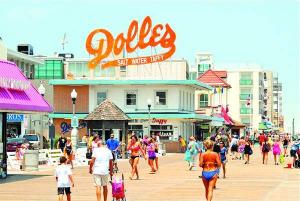Rehoboth sets hearing on ocean outfall
Rehoboth Beach and state officials are set to unveil the city’s environmental impact statement on Rehoboth’s ocean outfall project. No alarms and no surprises are expected at the 1 p.m., Tuesday, April 10 public hearing.
Rip Copithorn of international engineering firm GHD, which prepared the statement, said the goal of the meeting is to present the full statement to the public and gather comments. While it contains nothing new, Copithorn said he hopes the public will review the statement and ask questions.
The draft environmental impact statement, required to receive state funding for the $30 million project, recommends ocean outfall over other alternatives such as land application because the outfall is less expensive to build, will cause smaller increases in sewer rates for residents and has minimal environmental impact.
The statement describes ocean outfall as the “most practical solution considering the availability of land and the protection of groundwater and water quality of the Inland Bays. Also, this alternative has the lowest impact on estimated user charges and greatest acceptance by citizens of Rehoboth Beach.”
Ocean outfall has relatively low operational requirements, the statement said, requires the least maintenance and does not transport nutrients into the Inland Bays. Ocean outfall is also the most cost-effective solution; since after paying back the state’s loan, the city’s only costs would be operations and maintenance.
Land application would require the city to make payments to Sussex County or a private entity well after the loan is paid off, the statement says.
The statement also examines the outfall’s impact on aquatic plants, fish and wildlife.
“All of the fish species associated with the area of concern are highly mobile and migratory, and all mammals near the project extend far beyond the area. Any contaminant potentially present is rapidly diluted to below minimum water quality standards or to nondetectable levels,” the statement said.
Lastly, the statement examines the outfall’s impact on sewer rates. In 2009, the average sewer rate in Rehoboth was $326 per year. Once the outfall has been built, the average sewer rate is expected to jump to $635 per year. The city has slowly been increasing the wastewater surcharge since 2008; the average surcharge has increased 50 percent over the last four years.
Rehoboth was put on the path to ocean outfall back in 2002, when the city agreed to a court-ordered consent order to cease dumping treated effluent into the Lewes-Rehoboth Canal by Dec. 31, 2014.
In 2005, GHD, then known as Stearns and Wheler, put together a report outlining the city’s options and ultimately recommended ocean outfall. Over the next three years, the city debated ocean outfall and land application, ultimately rejecting the latter because of the high cost of land and the lack of control the city would have over costs.
The proposed project would pump treated effluent from the Rehoboth Wastewater Treatment Plant to the outfall pipe 6,000 feet off the shores of Deauville Beach. The effluent would be pumped through a piping system that leads down State Road through Grove Park and under Henlopen Avenue to the outfall site. The city would use a combination of open trench cutting and directional drilling to build the pipe.
The outfall pipe and diffuser would be directionally drilled along the ocean floor, using the parking lot at Deauville Beach as a staging area.
Copithorn said information now available in the plan that wasn’t previously available is modeling data collected in fall of 2010 and summer 2011. This modeling was conducted to show the best site for the diffuser and to estimate the rate at which the treated effluent would dilute.
The public hearing will feature a brief presentation by the Department of Natural Resources and Environmental Control on its role and responsibilities in the project, followed by a brief summary of the statement and then a comment period for the public and interested parties.
Copithorn said public comment will be received until Thursday, May 10. He said after the comment period, DNREC will take 30 days to collect the comments, and then the city will have 60 days to address all the comments. Copithorn said he expects the final statement to be ready by late summer.
To view the draft statement, go to www.cityofrehoboth.com. Written comments can be sent to Greg Pope, Department of Natural Resources and Environmental Control, Financial Assistance Branch, 5 E. Reed St. Suite 200, Dover 19901. Comments can also be sent via fax to 302-739-2137 or emailed to Rehoboth_EIS_Comments@state.de.us. Electronic submission is preferred.
Ryan Mavity covers Milton and the court system. He is married to Rachel Swick Mavity and has two kids, Alex and Jane. Ryan started with the Cape Gazette all the way back in February 2007, previously covering the City of Rehoboth Beach. A native of Easton, Md. and graduate of Towson University, Ryan enjoys watching the Baltimore Ravens, Washington Capitals and Baltimore Orioles in his spare time.



















































